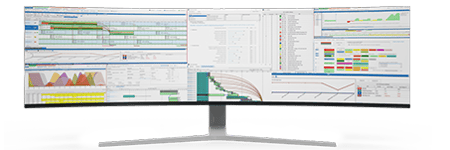Optimizing Production Planning KPIs
For Operations Directors in pharmaceutical manufacturing, one of the most critical aspects of maintaining efficiency, quality, and regulatory compliance lies in the ability to measure and manage performance effectively. Key Performance Indicators (KPIs) for production planning are invaluable in this regard. When optimized, these KPIs help ensure that operations align with corporate goals, minimize bottlenecks, and meet strict industry standards.
Integrating advanced scheduling and planning tools like PlanetTogether with enterprise systems such as SAP, Oracle, Microsoft, Kinaxis, or Aveva can streamline KPI tracking and make the data actionable.
This blog explores essential KPIs for production planning in pharmaceutical manufacturing and how system integration can elevate the efficiency and accuracy of your operation.

Key Production Planning KPIs in Pharmaceutical Manufacturing
Before looking into the role of system integration, it's essential to outline some KPIs critical for optimizing production planning in pharmaceutical manufacturing.
On-Time In-Full (OTIF) Delivery Rate
OTIF is a fundamental KPI that assesses whether products are delivered on time and in the correct quantity. In a sector where timeliness directly impacts patient outcomes, OTIF is crucial. A low OTIF can indicate planning issues, such as production delays or inventory shortages.
Cycle Time and Lead Time
Cycle time measures the duration needed to complete a specific production process, from raw material processing to finished goods. Lead time, on the other hand, encompasses the total time from order receipt to delivery. Monitoring both KPIs is essential to identify inefficiencies within the production line.
Capacity Utilization
Capacity utilization rates indicate how effectively the production resources are being used. Underutilized capacity often implies inefficiency, while overutilized capacity may lead to quality issues and equipment breakdowns, which can be detrimental in a regulated industry like pharmaceuticals.
Inventory Turnover Rate
Inventory turnover rate measures how quickly raw materials and finished products move through the supply chain. Efficient inventory management is critical for cost control and for meeting Good Manufacturing Practice (GMP) regulations, as it ensures that materials are stored only for as long as necessary.
First Pass Yield (FPY) and Right First Time (RFT)
FPY measures the proportion of units that pass inspection the first time, without rework. RFT tracks the accuracy of process steps, ensuring that operations align with regulatory requirements. High FPY and RFT rates demonstrate operational consistency, reducing waste and optimizing resource use.
Downtime
Tracking downtime, especially unplanned downtime, helps in identifying the primary causes of interruptions. Pharmaceutical production downtime can affect delivery schedules, increase costs, and impact product quality, making this KPI a priority.
![]()

Why Integrate PlanetTogether with SAP, Oracle, Microsoft, Kinaxis, or Aveva?
While KPIs are essential for tracking production planning performance, achieving real-time visibility and control over these metrics can be challenging without robust systems. Integrating PlanetTogether with SAP, Oracle, Microsoft, Kinaxis, or Aveva provides the visibility, automation, and coordination necessary for optimal production planning KPI performance. Here’s how:
Enhanced Real-Time Visibility Across Systems
Integrating PlanetTogether with SAP or Oracle can give Operations Directors a consolidated view of production schedules, inventory levels, and quality metrics in real-time. This integration allows pharmaceutical companies to reduce the delays and errors that often occur with manual data entry and fragmented systems. Real-time visibility makes it easier to monitor KPIs like OTIF, lead time, and inventory turnover, allowing for faster, data-driven decisions.
Automated Data Flow for Accurate KPI Measurement
With Microsoft or Kinaxis, data synchronization between PlanetTogether and ERP systems ensures that KPIs reflect the latest information across production, inventory, and supply chain. This automation eliminates discrepancies and enhances the accuracy of critical KPIs like capacity utilization, cycle time, and inventory turnover rate.
Agile Response to Demand Fluctuations
Pharmaceutical manufacturers face fluctuating demand due to changes in regulations, seasonality, or public health needs. Integrating PlanetTogether with systems like Aveva enables scenario planning, helping operations to quickly reallocate resources, adjust schedules, and maintain high OTIF and capacity utilization rates. Such agility is vital in preventing stockouts and ensuring timely delivery to customers.
Proactive Downtime Management
Downtime is a common yet costly occurrence in pharmaceutical production. Integration between PlanetTogether and a system like SAP or Oracle provides predictive analytics and maintenance scheduling capabilities. By aligning maintenance schedules with production planning, downtime can be minimized, ensuring consistent production flow and avoiding sudden interruptions that impact OTIF and cycle times.
Compliance and Quality Control
Integration helps in managing FPY and RFT KPIs by linking production and quality systems. When PlanetTogether integrates with SAP or Microsoft, quality control can be integrated directly into production workflows. Automated alerts and checks ensure that quality standards are maintained at every step, making it easier to comply with GMP and FDA regulations.
Improved Collaboration and Communication
Integration with systems like Kinaxis enhances communication between departments, from procurement to quality control. This cross-functional visibility promotes cohesive operations, where everyone from production managers to quality assurance teams can monitor KPIs in real-time. This transparency leads to more synchronized production schedules and quicker responses to any deviations, fostering a culture of continuous improvement.

How to Leverage KPIs with System Integration for Operational Success
Set Benchmarks and Define Success Metrics
Set KPI benchmarks by evaluating historical data and industry standards. For instance, pharmaceutical companies often aim for an OTIF rate of 98% or above. Integrated systems can streamline the process of establishing these benchmarks, as data is accessible and consistent across platforms.
Optimize Production Scheduling
With PlanetTogether and SAP, production schedules can be dynamically adjusted based on capacity utilization and lead time KPIs. By setting these schedules within a single system, Operations Directors can anticipate bottlenecks, allocate resources effectively, and respond to demand shifts proactively.
Implement Predictive Maintenance Programs
To control downtime, integrate predictive maintenance with PlanetTogether’s scheduling tools. This approach, often facilitated through integration with Microsoft or Aveva, enables proactive identification of potential issues, reducing the risk of sudden equipment failure. By synchronizing maintenance with production cycles, downtime can be minimized, positively impacting lead time and capacity utilization.
Conduct Regular KPI Reviews
Regularly review KPIs within your integrated system. Automated dashboards can display KPIs like FPY, RFT, and inventory turnover in real time. Using a system like Oracle for these analyses allows the team to drill down into specific data, such as identifying the root causes of low FPY or pinpointing underutilized equipment.
Foster a Data-Driven Culture
Encourage a culture of accountability by making KPI performance visible across the organization. With integration between PlanetTogether and Kinaxis, departments can monitor KPIs in real time, increasing ownership over production outcomes and enabling team members to contribute actively to process improvements.
Invest in Employee Training and Development
The best tools and KPIs are only as effective as the teams using them. Integrated systems are highly efficient but often complex, requiring well-trained staff to use them optimally. Ensure team members understand both KPI targets and how to use integrated systems effectively. This training can reduce errors and promote a proactive approach to managing KPIs.
For an Operations Director in pharmaceutical manufacturing, optimizing production planning KPIs is not only a way to measure success but a pathway to operational excellence. Integrating PlanetTogether with ERP Systems like SAP, Oracle, Microsoft, Kinaxis, or Aveva provides a unified platform where data flows seamlessly, automating KPI tracking and enabling agile responses to the demands of the industry.
By leveraging integrated systems, pharmaceutical manufacturers can move beyond traditional KPI management, driving improvement through real-time insights, collaboration, and data-driven decision-making. In a sector that requires precision, compliance, and agility, a robust strategy for production planning KPIs—bolstered by integration—empowers pharmaceutical companies to meet their objectives efficiently and consistently.
The future of pharmaceutical manufacturing lies in harmonizing production processes with advanced technology, and by doing so, Operations Directors can elevate their facility's productivity, quality, and compliance to new heights.
Are you ready to take your manufacturing operations to the next level? Contact us today to learn more about how PlanetTogether can help you achieve your goals and drive success in your industry.
Topics: PlanetTogether Software, Integrating PlanetTogether, Optimized Capacity Utilization, Pharmaceutical Manufacturing, Inventory Turnover Rate, On-Time In-Full (OTIF) Delivery Rate, Cycle Time and Lead Time, First Pass Yield (FPY) and Right First Time (RFT), Enhanced Real-Time Visibility Across Systems, Automated Data Flow for Accurate KPI Measurement




















LEAVE A COMMENT